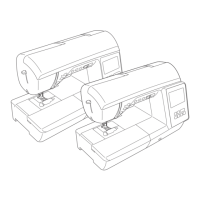
Do you have a question about the Brother NQ3700D and is the answer not in the manual?
| Brand | Brother |
|---|---|
| Model | NQ3700D |
| Category | Sewing Machine |
| Language | English |
Identifies and describes the main components of the sewing machine.
Step-by-step instructions for powering the sewing machine on and off safely.
Explains how to navigate and interact with the LCD screen for machine functions.
Lists and describes the items included with the sewing machine.
Allows adjustment of default machine settings, sewing, and embroidery parameters.
Customization options for machine operation, sound, display, and network connectivity.
Overview of operations and setup for wireless network connectivity.
Allows customization of touch key response levels for better usability.
Guides for enabling, requiring, and setting up the wireless network connection.
Instructions for winding thread onto a bobbin and placing it in the machine correctly.
Guides for threading the upper thread and pulling up the bobbin thread.
Guidance on selecting appropriate materials for different fabric types for optimal sewing.
Instructions for safely installing, checking, and replacing the sewing machine needle.
Step-by-step guide for changing the presser foot and its holder.
Overview of stitch options and how to perform basic sewing operations.
Explains reverse/reinforcement stitches and automatic securing functions.
Instructions for enabling the machine to automatically trim threads after sewing.
Details automatic presser foot lowering and fabric sensor adjustments.
How to use the pivot feature for easy fabric rotation during sewing.
Guidance on setting thread tension, stitch width, length, and L/R shift.
Helpful advice for improving sewing quality, including correct thread tension identification.
Tips for sewing cylindrical pieces, even seams, and aligning fabric.
Techniques for aligning fabric with markings or feet, and sewing different fabric types.
Specific advice for sewing delicate, elastic, and non-stick materials like leather.
Using the knee lifter for convenient presser foot operation.
Details on basic stitches like straight, zigzag, and overcasting, including a stitch chart.
Overview of decorative patterns and built-in fonts for embroidery and sewing.
Detailed guides for overcasting, blind hemming, and buttonhole creation.
Detailed instructions for sewing buttonholes and attaching buttons to fabric.
Techniques for creating decorative eyelets and fagoting seams.
Guides for sewing zippers and piping into fabric for finished seams.
Methods for decorative stitching used in appliqué, patchwork, and quilting projects.
Instructions for quilting, including using walking and free motion feet.
Specific guidance for using the free motion quilting foot for precise stitching.
Various decorative and functional techniques like elastic attaching and bar tacks.
Instructions for reinforcing fabric with bar tacks and repairing worn areas with darning.
Techniques for creating decorative eyelets, fagoting seams, and other specialized stitches.
Decorative stitches for collars, gathers, and fabric trims like shell tucks.
Decorative bridging stitches for joining fabric and techniques for sewing in multiple directions.
Techniques for multi-directional sewing and instructions for using a twin needle.
Instructions for twin needle sewing, decorative heirloom stitches, and step stitch patterns.
Fine-tuning stitches and managing saved patterns via memory and USB.
Creating and registering original stitch designs using the machine's interface.
Detailed steps for entering, moving, inserting points, and retrieving custom stitches.
Initial steps to set up the machine for embroidery, including part attachment.
Guide for connecting the embroidery unit and installing the correct embroidery foot.
Procedures for hooping fabric and applying stabilizers for optimal embroidery results.
Steps for placing fabric correctly into the embroidery frame and using an alignment sheet.
Steps for connecting the hooped frame to the embroidery unit securely.
Procedures for detaching the frame and legal notices regarding pattern usage.
How to choose and load embroidery patterns, including different pattern types.
Choosing character, frame, and combining patterns, plus initial editing capabilities.
Ensuring correct placement of the embroidery pattern on the fabric before stitching.
Step-by-step guide for embroidering patterns, including thread changes and auto-cut.
Options for displaying thread colors and procedures for replacing the bobbin during embroidery.
Handling thread breaks, resuming embroidery, auto foot down, and tension adjustments.
Resolving issues with upper and bobbin thread tension during embroidery.
Troubleshooting bobbin tension and managing automatic thread cutting and trimming.
Detailed steps for creating appliqué designs using embroidery techniques.
Using frame patterns to create appliqué designs with precise outlines.
Interface for modifying embroidery patterns like size, rotation, and color.
How to embroider large designs exceeding hoop size by splitting them into sections.
Screen for finalizing embroidery settings before stitching.
Adjusting pattern position and linking characters for continuous embroidery sequences.
Rearranging embroidery thread colors to minimize spool changes during stitching.
Instructions for cleaning, maintaining, and storing the sewing machine properly.
Solutions for common problems encountered during machine operation and setup.
Correcting thread tension issues and removing fabric caught in the machine.
Detailed steps for safely extracting fabric jammed within the machine's mechanisms.
Resolving thread tangles under the bobbin winder and general thread tension problems.
Verifying correct operation and installation after maintenance tasks.
Solutions for incorrect embroidery pattern execution and fabric loop issues during stitching.
Explains common error messages displayed on the LCD and provides solutions.
Resolving errors related to patterns, USB media, and wireless network credentials.
Resolving errors related to pattern loading, USB access, and control button conflicts.
Finding wireless credentials and understanding machine beep signals for diagnostics.